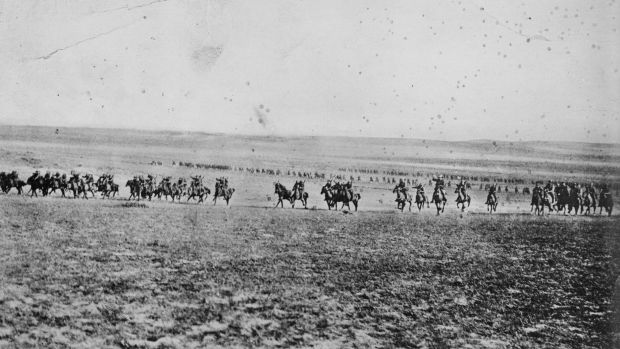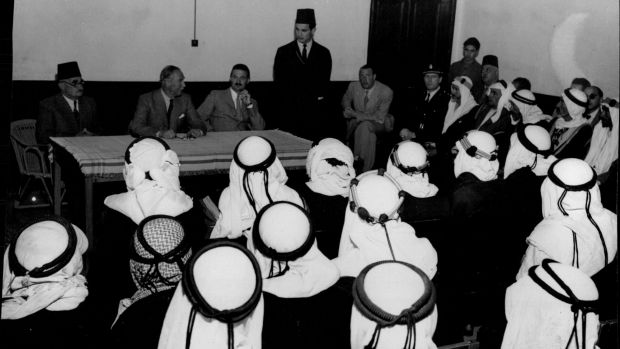Don't go there
Don't go there: The missing Arab piece of Beersheba's centenary events
By Sol Salbe, The Age, 29 October 2017
It isn't the first thing most people would think of, but the final outcome of the New Zealand elections reverberated more than 16,000 kilometres away. Prime Minster Jacinda Ardern appears to be far too busy to travel to Beersheba in Israel.
Her predecessor, Bill English, was meant to join Australia's Malcolm Turnbull and Israel's Benjamin Netanyahu there to commemorate the capture of the town by the Anzacs 100 years ago. In the interim it was decided that New Zealand Governor-General Dame Patsy Reddy would go.
That the event is worth noting is not in dispute. It took gumption and bravery to overrun the town. The victory of the Light Horse Brigade on October 31, 1917 caused the collapse of the Ottoman lines and allowed General Sir Edmund Allenby to enter Jerusalem less than two months later. It is no wonder, then, that the leaders of Australia and New Zealand are proud to recall it.
A photograph once believed to depict the charge of the 4th Light Horse Brigade at Beersheba on October 31, 1917. It is now believed to have been taken by photographer Frank Hurley in February 1918. Photo: Australian War Memorial.
For its part the City of Beersheba is certainly pulling out all the stops to the celebrate the occasion. There's an exhibition of contemporary Australian art, a staging of Verdi's opera Nabucco, with its theme of a lost Jewish homeland, various official ceremonies and a recreation of the cavalry charge. There is even a memorial ceremony for the Turkish fallen at the city's monument of the Turkish soldiers.
Only one group of people is missing. The city is marking, in its own words, the centenary of the liberation of Beersheba. So where is the mention of the grateful residents of the town in all the razzmatazz?
A perusal of the city's website isn't very enlightening. It tells you that "the city as we know it today is relatively new and was only established at the beginning of the 20th century under the Ottoman Turkish rule". But it is silent - in English and in Hebrew - as to who was living there to be liberated back in 1917.
And of course there's nothing at all on the website in Arabic, Israel's other official language. Which is rather incongruous, considering that in 1917 every single resident of the town spoke Arabic. The residents of Beersheba, including its mayor, were Bedouin and other Palestinians. There had been some Arabic-speaking Jewish community members living in the town, but they had all left during the war.
The Bedouin had an extensive existence in Beersheba and its environs, and despite their live-and-let-live attitude were quite antagonistic towards the Ottoman Empire and its rule. While there are no records that I could find of them welcoming the Anzacs, they probably thought a new empire couldn't be any worse.
Indeed, the British maintained many of the structures of governance. They kept the same courts and worked with Bedouin elders to resolve issues. The British continued to provide free education to Bedouin boys in Beersheba and even set up a school for girls. Bedouin youngsters travelled to other parts of Palestine and even abroad to study. The town had a small eight-bed hospital to which both Bedouin and British Mandate authorities contributed.
The British recognised the Bedouin land title system, even though the Bedouin had never bothered to register their own holdings under the Ottomans. While the Bedouin paid tax on their flocks and on their land, they refused to deal directly with the authorities as they suspected the registration would lead to them being conscripted into the Ottoman Empire's military. The British saw no point in changing the arrangements and even helped introduce modern agricultural techniques, including the use of tractors for ploughing.
Beersheba, April 1947: the British High Commissioner in Palestine, Sir Alan Cunningham (seated at centre of table), addresses Bedouin elders from Beersheba and Gaza regarding a drought in the area.
The Bedouin did have some issues with British. Within days of the capture of Beersheba they became aware of the Balfour Declaration which "view[ed] with favour the establishment in Palestine of a national home for the Jewish people". They strenuously objected to the sale of land to Jews who wanted to set up agricultural communities in the area. In 1938, at the height of the Arab Revolt in Palestine, Bedouin joined forces with other Palestinian rebels to briefly take Beersheba back from the colonial power.
If Beersheba's inhabitants had had a premonition that Balfour's declaration would have an adverse impact on them, it was finally realised almost 31 years later. On October 22, 1948, their town was captured again, this time by the Israel Defence Forces. The consequences for the Bedouin were devastating.
Sasson Bar-Zvi, military governor of the Negev from 1963 to 1968, told Ben-Gurion University historian and author Mansour Nasasra: "In the war people were exiled or left to many other places. By the end of the war the main Bedouin city of Beersheba was empty of Bedouin. No Bedouin, no Gaza businessmen, no shopkeepers, and not even any birds remained in the city. After the war had ended some new Jewish immigrants started to come to the city."
Since then, the Negev Bedouins' lot hasn't been a happy one, with many of their villages unrecognised by the Israeli authorities, meaning they are not connected to water or electricity or entitled to protection from rockets that may strike them from neighbouring Gaza or Sinai. In Beersheba itself their main presence was the famous Bedouin Market. Sadly earlier this year the city council decided to close it.
The Israeli government has made several attempts to deal with the issue of unrecognised villages and the lands for which the Bedouin claim the equivalent of Australia's native title. The various versions of the Prawer plan have all failed to recognise what the Bedouin demanded as a right: that the land was theirs and that their possession of it was good enough for the Jewish National Fund to accept and buy some of it before the state of Israel was created.
Even recognised Bedouin townships are at a disadvantage. There is a huge amount of arnona (local government rates) being paid by the Defence Ministry and other entities for their substantial land holdings in the Negev. Invariably these taxes are paid to Jewish municipalities rather than Bedouin ones, even when the Bedouin municipality is far closer.
New Zealand's progressive new PM might well be hesitant about a cornucopia of commemorative events all ignoring a section of the region's citizenry. But her newly installed Foreign Minister Winston Peters, a Maori politician, or even Dame Patsy, long an advocate for diversity, would find similar challenges if they looked hard enough.
Imagine accompanying Turnbull to the launch of a new nippers program on an Israeli beach. What would happen if, sensitive to issues of diversity, a New Zealand representative asked about nippers belonging to the local Arab minority? After all, according to Israel Hayom, the newspaper with the largest circulation in the country, an Arab child was 50 per cent more likely to drown in Israel's latest May-to-October swimming season than a Jewish one.
What might happen if that representative were told that the nippers course so far runs in Hebrew only, making it next to impossible for Arab kids to participate?
Best not to go there.
Source: The Age


